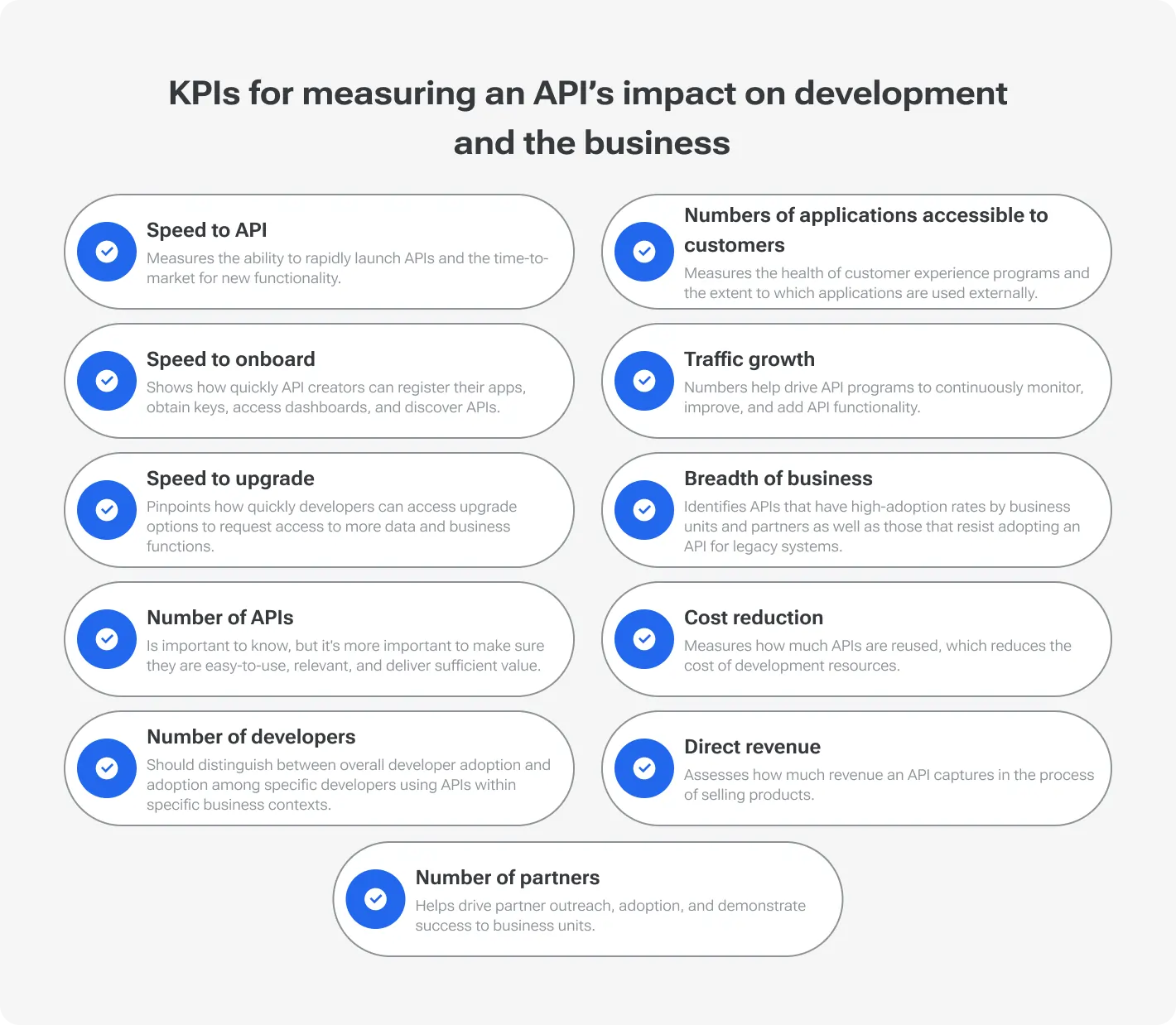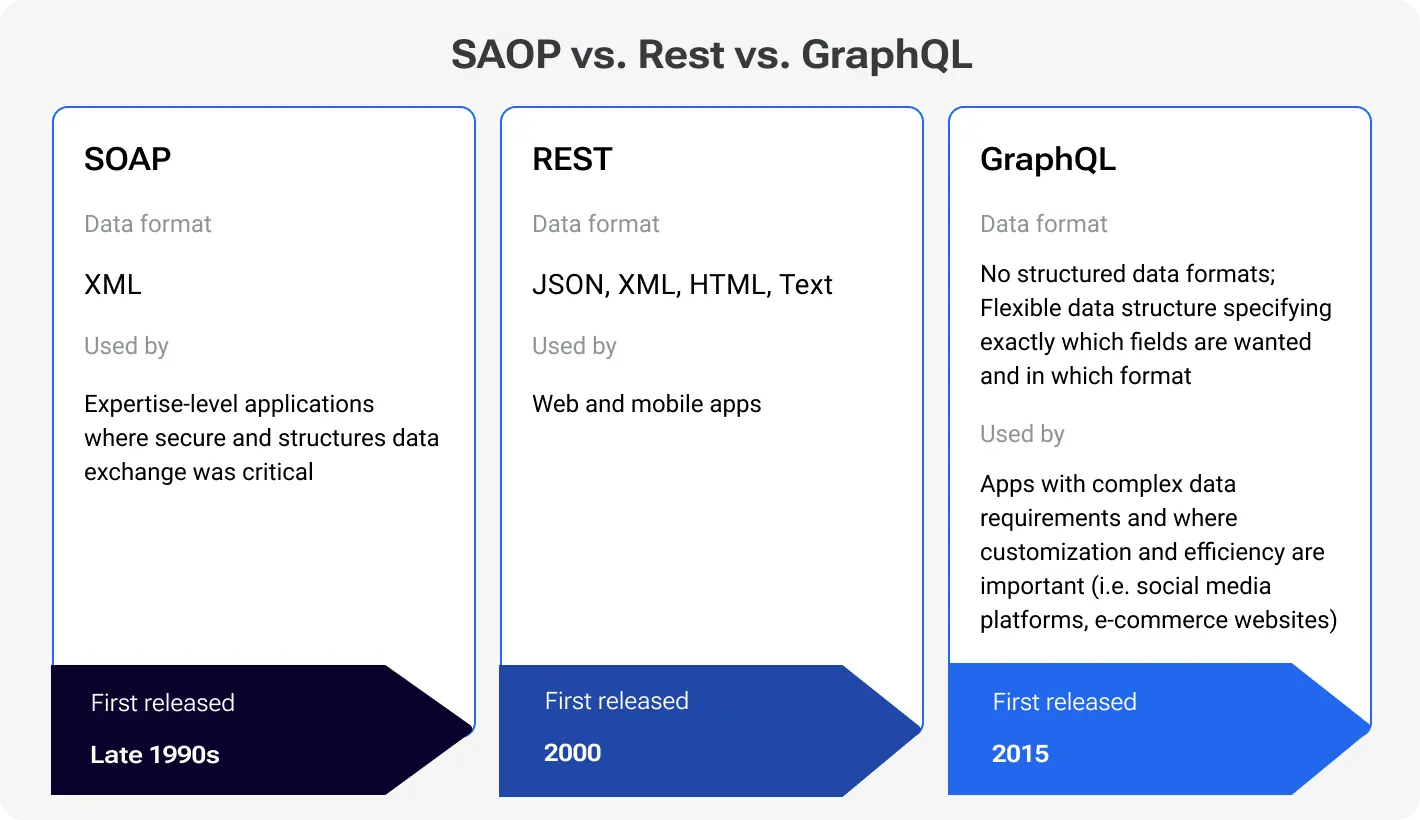APIs have become indispensable for the optimization and facilitation of different business processes: companies in various niches are developing and integrating APIs at an unprecedented pace. According to GlobeNewswire, the global API management market will grow from USD 7.67 billion in 2024 to USD 16.93 billion by 2029 at a compounded annual growth rate (CAGR) of 17.1%. These statistics demonstrate the demand for comprehensive API integration tools and expertise on the matter. If you haven’t developed and integrated a native API for your company yet, what are you waiting for?
This article aims to provide expert tips and tricks for smooth API integration for different business types and niches. We will talk in detail about the essence of API integration, strategic planning, best practices, and the most common pitfalls. All insights are taken from the professional practice of seasoned API integration experts.
Bridge the gap with seamless API solutions for product integration
API integration: What is it, in reality?
API integration is development and deployment of an Application Programming Interface for a website or application. APIs help connect different software systems and establish seamless communication, allowing users to retrieve data using a request-response format. APIs are used in practically every single web-based project you can think of.
For instance, Google Maps API allows websites to integrate maps, pinpoint locations, and share geolocation data within their platforms and applications. One of the most-used taxi apps in the world, Uber, integrates Google Maps API to provide drivers and riders with correct geolocation data, route planning mechanisms, and real-time ETAs.
Another famous example of successful API integration is the use of X API (formerly Twitter) by world-famous news platforms like Bloomberg to showcase relevant posts and feeds by attaching them to articles. In a similar way, websites can use the X Login API to allow users to sign up or log in with just one click using their X accounts.
These and many other examples allow us to define the main benefits of smooth API integration, which include but are not limited to:
Improved efficiency: APIs simplify otherwise long and tedious processes by allowing websites and apps to communicate with each other and retrieve loads of data in a matter of seconds.
Enhanced functionality: APIs open doors to innovation in website and app functionality, providing developers with tools needed to implement new features and further simplify the existing ones.
Better user experiences: smooth API integration facilitates user experiences, which is the end goal of any API development and deployment. For example, it allows end-users to log into multiple websites and apps using one and the same social media account, which spares them from the need to come up with a new login and password for every single platform they interact with.
With enough preparation and dedication to quality API development, you will be able to automate the processes of your team and improve their accuracy. Successful API deployment starts with a strong strategy that allows you to clearly define which objectives you want to achieve with your API. For this, you will need to use a bunch of expert API tricks, which we will gladly provide below.
Strategic planning for API integration
Strategic planning for API implementation starts with compiling a checklist and following it religiously. carefully planning and architecting your API, one can create a robust and developer-friendly interface that meets the needs of both the organization and its users.
Define objectives
For starters, clearly define your business goals to understand how API integration can assist you in achieving them. Try to break the list into smaller, achievable milestones, and think about how each one can lead to reaching a bigger goal. Your key considerations might include:
Revenue growth: Consider whether you can use the API to create new revenue streams, for example by offering new services like subscription models or partnering up with third parties for extra services;
Operational efficiency: Think of how the API can automate your business processes and streamline workflows, as it can potentially save your budget from inconsiderate expenses;
Customer retention and satisfaction: Imagine the ways API integration can improve user experience, making your product more valuable and recognizable compared to competitors;
Innovation and competitive advantage: Evaluate if the API integration can give you a competitive edge and help you respond faster to market demands.
Imagine an online shop integrating a payment API. This strategic move can help the company speed up and streamline the checkout process because many customers tend to abandon their carts once they see that they have to input all of their payment data manually. A payment API automates the procedure entirely, allowing customers to pay in one click, which, in the long run, improves customer satisfaction and boosts revenue streams.
Measure your API success
To measure how successful the API integration is for your particular business, set Key Performance Indicators (KPIs), which may include time saved on processes, revenue growth from new API-driven services, or customer satisfaction metrics. In the process, it is also important to understand client requirements and put yourself in the shoes of your potential end-user. Consider the following factors:
How accessible and easy-to-use your API is;
How consistent and fast it is in its response under different loads of requests;
How secure your API is, especially when it is built to handle sensitive information;
Whether it is possible to personalize your API and allow users to customize their experience;
How well your API integrates with other tools, systems, or platforms.
For example, a health app can integrate with a wearable device API in order to accurately track user data and ensure privacy for health metrics. These features create a rounded user experience with the app, making it more portable and easy to use at any time and from anywhere.
Stakeholder engagement
Apart from the client's needs, it is important to ensure that the final product of the API integration meets the business goals. Therefore, one must engage both internal and external shareholders early in the process to listen to their requirements and identify potential challenges.
Engaging internal stakeholders boosts collaboration across departments. These stakeholders can be developers, project managers, data security teams, and business analysts. Each one of them can bring something useful to the table:
Development and IT teams can provide insights on technical feasibility, scalability, and legacy system limitations that might impact integration.
Security teams can identify and mitigate potential vulnerabilities, helping to ensure that data protection and regulatory compliance are integrated into the API from the beginning.
Business analysts and product teams bring an understanding of user workflows and market requirements, ensuring that the API aligns with customer needs and the company’s broader goals.
In the same way, engaging external stakeholders, such as partners, end-users, and third-party developers, will provide a more profound value outside just the internal needs of the company. Different external stakeholders can contribute to the project in different ways, for instance:
End users can provide feedback on desired functionality, usability, and common pain points, which can guide user-centered design.
Partners may have specific requirements or use cases that can impact API design, especially if they rely on the API for mission-critical functions.
Third-party developers who will build on the API might need comprehensive documentation, sandbox environments, or specific data formats to integrate smoothly.
It is crucial to align the expectations of both sides before starting to develop an API. When both internal and external stakeholders know what to expect from the API and are ready to bring in their feedback and contributions, the project’s adoption is more likely to succeed.
Success metrics
Apart from the KPIs, one must clearly define the success metrics when developing an API. These metrics help ensure that the API meets business objectives and user expectations, as well as tech standards and requirements before it is deployed. The success metrics you might want to include are:
Response time indicators measure how quickly the API responds to a request after it is made. Slow response times always negatively impact user experience, so you want to avoid this issue at all costs. Consider a company like Amazon web services (AWS), which highlights the importance of low-latency APIs, in which fast response times can significantly improve user satisfaction and system efficiency.
Uptime, which measures the reliability of an API. All successful APIs strive for 99.9% uptime or higher, which minimizes service interruptions. A high uptime is especially relevant for platforms that rely on uninterrupted flows of data, for example, payment getaways or cloud-based SaaS platforms like Stripe.
Error rates are another critical KPI. Keep an eye on the error rates of your API to promptly detect issues with its functionality. Tools like New Relic and Datadog can be of help when you need to monitor API errors and get notified about errors in real-time.
User satisfaction is a qualitative KPI that reflects how well the API meets the needs of its users. You can use different methods to evaluate it, such as user feedback, surveys, and user retention metrics. Adopt the example of Twilio, a company that constantly collects user feedback and uses it promptly to improve API features.
The adoption rate is a metric that measures how many third parties are using your API. This metric is particularly important if you are using an API-driven business model, such as, for example, Salesforce. Salesforce allows third-party developers to create applications based on their API, and adoption rates reflect the overall performance of the API in this process.
Сompliance and security of your API. Before developing and deploying an API, verify that it complies with the relevant laws, regulations, and industry standards, for instance, the GDPR or the PCI DSS. Do not neglect the robust security methods, such as authentication and authorization, make sure that your API passes all the necessary security and compliance checks.
By tracking all of these metrics, you can assess the success of your API integration the most clearly. Besides, if you start tracking them early on, you are more likely to avoid technical or legal repercussions that might occur when an API is not assessed adequately before its launch.
Best practices for smooth API integration
While developing and integrating an API, it is important to keep in mind the API best practices that have helped thousands of businesses achieve project success. It is difficult to misfire when you resort to the time-tested methods that have been proven reliable and effective by your fellow developers or entrepreneurs. Therefore, here are the best practices for smooth API integration regardless of its niche or purpose.
Choose the right APIs
For starters, you must choose the right type of API that suits your project needs. There are the three most common API types you can choose from depending on what you want to build: REST APIs, GraphQL APIs, and SOAP APIs. In our API integration tips, we often touch upon the benefits and possible downsides of each type for different business niches and projects.
REST API (Representational state transfer)
REST is one of the most commonly used types of APIs. It is ideal for stateless, simple interactions where data is accessed using HTTP methods, such as GET, POST, PUT, and DELETE. E-commerce applications, for instance, commonly use REST APIs to retrieve product details, process orders, or manage user accounts.
In addition, a social media platform like X (formerly Twitter) actively uses a RESTful API for retrieving posts for the For You page based on the user’s previous likes and general preferences. The main pros of REST APIs are that they are the simplest to design and implement, widely supported by various platforms, scalable, and flexible.
GraphQL API
Developed by Facebook, GraphQL works the best in cases where you want to allow the end-user to specify exactly what data they need to retrieve. One of the most popular use cases of GraphQL is for Facebook push notifications: thanks to the GraphQL subscription feature, the platform can push updates to users whenever they get a like, comment, or new message. This allows for real-time updates in the Facebook feed, retrieving only the data relevant to a particular user and nothing more. The main benefit of GraphQL is the reduced number of API calls, which might otherwise overload the server.
SOAP API (Simple object access protocol)
SOAP APIs are used for enterprises that require XML-based formal contracts and strict security. These kinds of APIs are most popular among banks that want to provide secure transactions with other financial institutions, as well as Telecom companies that want to integrate phone services with billing systems. Their main advantages are strong security and support for ACID compliance (Atomicity, Consistency, Isolation, Durability).
Design and documentation
One of the most common approaches to designing an API is to use RESTful design principles across all API endpoints. The simplest example of it would be using the same verbs, such as POST for create or GET for read. Thanks to this, you will ensure that developers can easily understand and work with your API. Salesforce’s API, for instance, follows a RESTful approach that makes integration consistent and intuitive.
Take Shopify’s API documentation as an example. It includes examples, use cases, endpoint details, and common errors. For an e-commerce platform integrating with Shopify, this level of detail allows developers to troubleshoot issues quickly, understand API limitations, and build integrations more effectively.
Choosing the right API development partner: What to look for
Security measures
Security measures are always paramount but especially so when it comes to an API that’s designed to handle sensitive data. Take any health-tracking application that uses the Cerner API for patient records. It uses such measures of safety as OAuth 2.0 and JWT tokens for secure authentication and authorization.
They can help prevent unauthorized access and protect patient data from third-party interference. When it comes to data protection, it is also crucial to be compliant with regulations like GDPR or PCI DSS, especially if your target users are from regions with strict data protection laws.
Testing and quality assurance
Testing an API during its development and post-deployment is another vital aspect of the integration process. API testing allows you to see how well it performs in different circumstances and detect any possible issues promptly. Consider a platform like GitHub, which tests its API endpoints using automated testing tools like Postman and Newman. Given that GitHub uses versioning and frequently updates its API, automated testing helps ensure that it stays reliable even through all updates and changes.
It is highly advised to add user acceptance testing (UAT) to your API testing routine. As an example, take integrating an API for a public transit app, for instance, the Google Maps API for location and directions. In this case, you would perform UAT with real users to confirm that the API provides accurate routes and relevant information under conditions like rush hours or delays. This testing phase ensures that the integration meets the users’ needs and provides a smooth experience.
Expert tips and tricks
Apart from the best practices in API development and implementation, we have collected a number of expert tricks that we have used countless times in our own API integration experience. These lifehacks can make your API perform better under varying loads of data, improve uptime, and ensure watertight security:
Modular integration. It can be difficult to navigate API integration with little to zero experience. To simplify the procedure, you might want to break down the integration process into manageable modules to simplify implementation and troubleshooting;
Graceful error handling. No API is ever perfect, and errors tend to be very common even for huge platforms. This is why it is important to implement effective error-handling mechanisms to manage and log errors without disrupting user experience.
Caching and rate limiting. Since APIs often tend to get overloaded when processing big amounts of data, caching, and rate limiting can prevent overloading and improve performance.
Real-time monitoring. Improving your API doesn’t stop after it’s already rolled up. To ensure a smooth performance, set up real-time API monitoring and be ready to test and get rid of errors and bugs promptly.
Analytics. Use analytics tools like Google Cloud Apigee, New Relic, Postman, or Datadog to gain insights into API usage patterns and identify areas for improvement.
A good example of a program constantly testing and improving its API is GitHub, a popular website for version control and collaboration. It uses API versioning to ensure that new updates do not interfere with the existing API performance, releases beta versions of the API for developer testing, uses canary releases for early access to new features, and properly documents all these processes for adequate success tracking.
Common pitfalls and how to avoid them
Integrating an API for your business processes can come with certain pitfalls, especially for not tech-savvy entrepreneurs. Therefore, it is important to rely on a trustworthy and verified partner when developing and deploying an API for the first time. In the table below, our expert team has compiled the most common pitfalls in API deployment and how to avoid them.
Jumping into API integration without thorough planning
Start with a requirements analysis, identifying which functionalities you need and how they align with the API’s capabilities. Develop a detailed project plan with milestones, including contingencies for potential challenges. Reviewing API documentation in detail and conducting early discussions with the provider can also clarify expectations and prevent misalignment.
Insufficient testing before API deployment
Establish a comprehensive testing framework that includes unit tests, integration tests, and end-to-end tests. Use automated testing tools to validate functionality regularly and conduct load testing to assess performance under varying conditions. Lastly, run User Acceptance Testing (UAT) with real users or stakeholders to verify that the integration meets requirements and expectations.
Neglecting proper API documentation
Document the API integration thoroughly, covering endpoints used, data structures, error-handling protocols, and known limitations. Make documentation easy to access, and keep it updated whenever changes are made to the API or integration logic. Tools like Swagger or API Blueprint can assist in creating and maintaining structured, accessible documentation.
Neglecting proper security and data security
Follow API security best practices, such as implementing OAuth 2.0 for authentication, encrypting data in transit with TLS/SSL, and securing API keys by storing them in encrypted environments. Regularly review access permissions and use data minimization practices to limit exposure to sensitive information. Additionally, ensure compliance with relevant standards (e.g., GDPR, PCI DSS) by implementing strong access controls and regular security audits.
Conclusion
To conclude, we must say that API integration is a beneficial step that can resolve many workflow issues and potentially improve the overall performance of a company. However, this is only given that it is developed, tested, and deployed smoothly. It is crucial to plan your API integration strategically, use the best practices, and consider expert tips for a smoother process, especially when integrating an API for the first time. Luckily, Devico provides expert assistance with all the mentioned points. Contact our experts to ensure the success of your API integration project.
Struggling to connect your siloed systems? Hire a reliable API provider.





